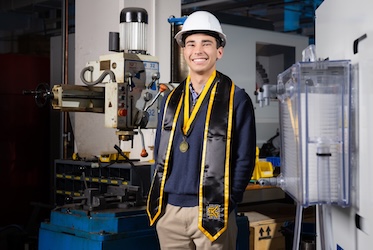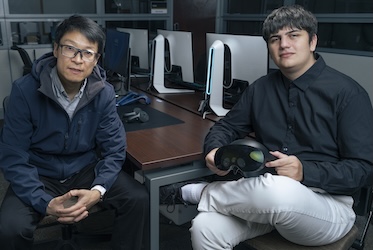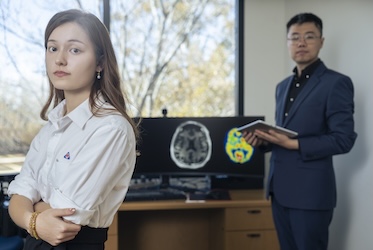

MARIETTA, Ga. | Oct 9, 2018
Students develop method to create indoor virtual maps using behavior data
Much like Google Maps collects information from motorists to plot out roadways, Kennesaw State University students are using data from smartphones to more efficiently map indoor spaces.
The research, conducted by Kennesaw State students Nick Murphy, Devan Patel, Drew Savas and Derek Martin, sought applications for a self-updating virtual map that could guide users through a space that experiences frequent changes to its layout, such as a museum or grocery store. Currently, developers must painstakingly take manual measurements of an interior before creating it virtually, which is problematic because it must be rebuilt each time the environment changes. The students hope the approach can be used on commercial applications as well as helping the visually impaired avoid obstacles in high-traffic areas.

“It reminds me of the time before Google Maps when we had to send people to take measurements in order to create a map,” said Rongkai Guo, an assistant professor of gaming in KSU’s College of Computing and Software Engineering. “Now, Google can use traffic data and dispatch cars to collect information in real-time. We wanted our students to create an indoor version of that by collecting anonymous data directly from phone users.”
To speed up the mapping process, the students – advised by Guo and Chao Mei, an assistant professor of software engineering and game development – have proposed a solution that aggregates information collected from smartphones and uses it to create an approximate model of a floor plan. Using a series of pebble-sized Bluetooth beacons mounted on walls, the students tested their proposal over the course of the spring semester within the University’s Atrium Building. By pairing the beacons with smartphones, the students could track the position of users throughout Atrium Building lobby and create a heat map of walkable areas.
“What we wanted to know is, could we use Bluetooth beacons to make a self-updating map based on people’s movement throughout that space,” said Murphy, who presented his research last month at the 10th International Conference on Virtual Worlds and Games for Serious Applications in Wurzburg, Germany. “If a hallway is closed off, for instance, the user traffic data will show that there is no one walking in that area and the map will update to show it’s closed. This eliminates the need to create an entirely new map based on what could be temporary maintenance.”

In its current form, the program created by the students won’t provide an exact model of the total environment, which includes the height or shape of objects. However, the data collected by the student researchers can give a very strong indication of where the hallways are and where obstacles could impede the flow of foot traffic. Murphy said this approach could be further developed to help visually impaired people navigate busy areas, such as a subway station. He and a team of students are currently conducting a follow-up study to explore applications that could help those who are disabled.
“I used to think virtual reality served only as a means of entertainment, but being able to see that this can have a positive impact on people made this project worthwhile,” Murphy said. “A lot of times people design based on their own abilities. I’m learning that we can use these tools to help disadvantaged people and have focused my research efforts there.”
– Travis Highfield
Photos by David Caselli

Discipline and determination drive track and classroom success for graduating student-athlete

Student, faculty researchers explore how AI can improve STEM learning through virtual reality

Student, faculty researchers use AI to improve early detection and diagnosis of Alzheimer's disease

Kennesaw State researchers use drones, artificial intelligence to improve disaster response
A leader in innovative teaching and learning, Kennesaw State University offers undergraduate, graduate, and doctoral degrees to its more than 51,000 students. Kennesaw State is a member of the University System of Georgia with 11 academic colleges. The university's vibrant campus culture, diverse population, strong global ties, and entrepreneurial spirit draw students from throughout the country and the world. Kennesaw State is a Carnegie-designated doctoral research institution (R2), placing it among an elite group of only 8 percent of U.S. colleges and universities with an R1 or R2 status. For more information, visit kennesaw.edu.